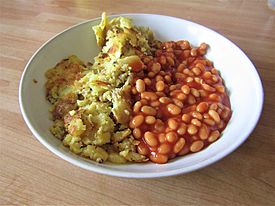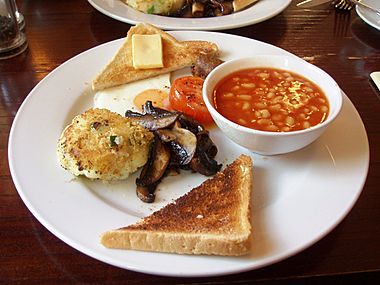Bubble and squeak facts for kids

Bubble and squeak (left) served with baked beans
|
|
| Place of origin | United Kingdom |
|---|---|
| Main ingredients | Potato, cabbage |
Bubble and squeak is a traditional British dish. It is made from cooked potatoes and cabbage. These vegetables are mixed together and then fried. It's often served as a side dish, especially with a Sunday roast or as part of a full English breakfast. People have been enjoying this dish for a very long time, since at least the 1700s!
Contents
History of Bubble and Squeak
The funny name "Bubble and Squeak" comes from the sounds the ingredients make. When the vegetables are frying in the pan, they make bubbling and squeaking noises! The name was first written down in 1762. Back then, the dish was a bit different.
In the early days, Bubble and Squeak mostly had cooked beef in it. Potatoes were not even a main part of the recipe! The first known recipe was in a cookbook by Maria Rundell in 1806. Her recipe used only cabbage and roast beef, seasoned and fried.
Later, other famous cooks like William Kitchiner and Mrs Beeton also shared their recipes. They still used beef and cabbage, sometimes with onions. The meat and vegetables were often served side-by-side, not mixed together.
Around the 1880s, potatoes started to appear in recipes for Bubble and Squeak. An 1882 recipe from The Manchester Times suggested mashing potatoes and mixing them with cold greens. This was then fried in butter or dripping. The meat was still served in the middle of the dish, with the vegetables around it.
Modern Bubble and Squeak
Today, Bubble and Squeak is usually made with just potatoes and cabbage. This change might have happened after the Second World War. During the war, food was rationed, and beef was harder to get.
Modern recipes often use cooked and mashed potatoes mixed with chopped cooked cabbage. Some cooks, like Delia Smith, use only these two ingredients. Others might add finely chopped raw onion or Brussels sprouts. The mixture is usually seasoned with salt and pepper. It is then fried until it gets a nice brown crust on the outside.
Chefs like Gary Rhodes sometimes use sliced Brussels sprouts instead of cabbage. He explains that Bubble and Squeak is different from colcannon. Colcannon is a creamy potato dish, while Bubble and Squeak is made from leftovers and fried until crispy.
Many cooks add other vegetables too. These can include courgettes, ham, bacon, leeks, swede, turnips, or carrots. Sometimes, it's shaped into small round cakes before frying. Other times, it's fried as one big pancake and then sliced.
Bubble and Squeak Around the World
Bubble and Squeak is well-known in Australia. Some Australian recipes even add peas and pumpkin to the mix. It's not as common in the United States, but it's not unknown there either. In Canada, people have also enjoyed this dish for many years.
Similar Dishes
Many countries have dishes that are similar to Bubble and Squeak. They often use leftover vegetables and potatoes.
|
|
Other Uses of the Term
The phrase "bubble and squeak" can also be used to describe something that is a mix of different things. For example, someone might say a new song is a "bubble and squeak mixture" if it has many different styles. The term has also been used as names for characters in children's books, like pairs of puppies or mice!
See also
 In Spanish: Bubble and squeak para niños
In Spanish: Bubble and squeak para niños



